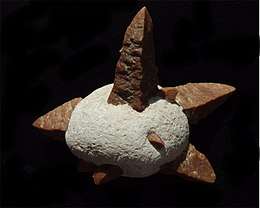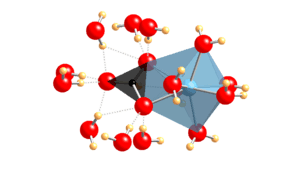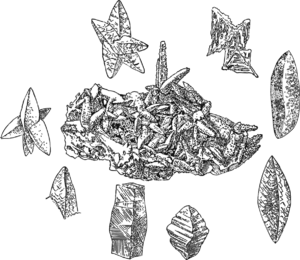Ikaite
Ikaite is the mineral name for the hexahydrate of calcium carbonate, CaCO3·6H2O. Ikaite tends to form very steep or spiky pyramidal crystals, often radially arranged, of varied sizes from thumbnail size aggregates to gigantic salient spurs. It is only found in a metastable state and decomposes rapidly by losing most of its water content once removed from near-freezing water. This "melting mineral" is more commonly known through its pseudomorphs.
| Ikaite | |
|---|---|
 Calcite after ikaite var. glendonite concretion | |
| General | |
| Category | Carbonate mineral, hydrous carbonates subgroup |
| Formula (repeating unit) | CaCO3·6H2O |
| Strunz classification | 5.CB.25 |
| Crystal system | Monoclinic |
| Crystal class | Prismatic (2/m) (same H-M symbol) |
| Space group | C2/c[1] |
| Identification | |
| Color | White when pure |
| Crystal habit | Nearly square prism; pyramidal; sigmoidal: square prism capped with oppositely canted pyramids; massive, tubular (tinolite vr.) |
| Mohs scale hardness | 3 |
| Luster | Dull |
| Streak | White |
| Specific gravity | 1.83 |
| Optical properties | Biaxial (−)[2] |
| Refractive index | nα = 1.455 nβ = 1.538 nγ = 1.545[3] |
| Birefringence | d = 0.090 |
| Other characteristics | Decomposes into water and calcite above 8 °C[2] |
| References | [1] |
Distribution
It is usually considered a rare mineral, but this is likely due to difficulty in preserving samples. It was first discovered in nature by the Danish mineralogist Pauly[4] in the Ikka (then spelt Ika) fjord in southwest Greenland, close to Ivittuut, the locality of the famous cryolite deposit.[5][6] Here ikaite occurs in truly spectacular towers or columns (up to 18 m or 59 ft tall) growing out of the fjord floor towards the surface water, where they are naturally truncated by waves, or unnaturally by the occasional boat.[7][8] At the Ikka Fjord, it is believed that the ikaite towers are created as the result of a groundwater seep, rich in carbonate and bicarbonate ions, entering the fjord bottom in the form of springs, where it hits the marine fjord waters rich in calcium.[8] Ikaite has also been reported as occurring in high-latitude marine sediments at Bransfield Strait, Antarctica;[9] Sea of Okhotsk, Eastern Siberia, off Sakhalin;[10] and Saanich Inlet, British Columbia, Canada. In addition it has been reported in a deep sea fan off the Congo, and therefore probably has worldwide occurrence. The most recent occurrence has been reported by Dieckmann et al. (2008).[11] They found the mineral ikaite directly precipitated in grain sizes of hundreds of micrometers in sea ice in the Weddell Sea and throughout fast ice off Adélie Land, Antarctica. In addition, ikaite can also form large crystals within sediment that grow to macroscopic size, occasionally with good crystal form. There is strong evidence that some of these marine deposits are associated with cold seeps.[12] Ikaite has also been reported as a cryogenic deposit in caves where it precipitates from freezing carbonate-rich water.[13]
Structure
Ikaite crystallizes in the monoclinic crystal system in space group C2/c with lattice parameters a~8.87A, b~8.23A, c~11.02A, β~110.2°.[14][15] The structure of ikaite consists of an ion pair of (Ca2+CO32−)0 surrounded by a cage of hydrogen-bonded water molecules which serve to isolate one ion pair from another.[16]

Stability
Synthetic ikaite was discovered in the nineteenth century in a study by Pelouze.[17] Ikaite is only thermodynamically stable at moderate pressures, so when found near the Earth's surface is always metastable.[18][19] Nevertheless, as it appears to be at least moderately common in Nature, it is clear that the conditions for metastable nucleation and growth cannot be too restrictive. Cold water is certainly required for formation, and nucleation inhibitors like phosphate ions for the growth of anhydrous calcium carbonate phases, such as calcite, aragonite, and vaterite probably aid its formation and preservation. It is thought that perhaps the structure of calcium carbonate in a concentrated aqueous solution also consists of an ion pair, and that this is why ikaite readily nucleates at low temperatures, outside of its thermodynamic stability range. When removed from its natural cold water environment, ikaite rapidly disintegrates into monohydrocalcite or anhydrous calcium carbonate phases and water, earning the nickname of the melting mineral.
Pseudomorphs
The presence of ikaite may be recorded through geological time through the presence of pseudomorphs of other calcium carbonate phases after it.[20] Although it can be hard to uniquely define the original mineral for every specimen, there appears to be good evidence for ikaite as the precursor for the majority of the following locality names of pseudomorphs:
- Glendonite, after type locality, Glendon, New South Wales, Australia.
- Thinolite, (Gr. Thinos = shore) found in the tufa of Mono Lake, California, US[21][22]
- Jarrowite, Jarrow, Northumberland, UK[23][24]
- Fundylite, Bay of Fundy, Nova Scotia, Canada
- Gersternkorner, (Ger. = Barleycorn)
- Gennoishi, (Jp. = hammerstones)[25]
- Molekryds, (Dan. = Mole Cross), Mors Island, Jutland, Denmark
- Pseudogaylussite (from semblance to Gaylussite)
- White Sea hornlets, White Sea and Kola peninsula.
Ikaite or its pseudomorphs have been reported as occurring in marine,[26] freshwater, and estuarine environments.[27]

The common ingredient appears to be cold temperatures, although the presence of traces of other chemicals such as nucleation inhibitors for anhydrous calcium carbonate may also be required. It has also been reported as forming in winter on Hokkaido at a saline spring.
Since cold water can be found at depth in the oceans even in the tropics, ikaite can form at all latitudes. However, the presence of ikaite pseudomorphs can be used as a paleoclimate proxy or paleothermometry representing water near freezing conditions.[28][29]
Thinolite deposits
Thinolite is an unusual form of calcium carbonate found on the shore (Greek: thinos = shore) of Mono Lake, California. This and other lakes now largely in the desert or semi-desert environments of the southwestern US were part of a larger post-glacial lake that covered much of the region near the end of the last glaciation. It is thought that at this time, conditions similar to that of the Ikka fjord allowed for the growth of massive ikaite.
Isotope geochemistry
Isotope geochemistry can reveal information about the origin of the elements that make up minerals. The isotopic composition of ikaite and the pseudomorphs is actively studied.[30] Studies of the ratio of 13C to 12C in ikaite relative to a natural, standard ratio can help to determine the origin of the carbon pool (organic/inorganic) which was consumed to form ikaite.[31] Some studies have shown that oxidizing methane is the source of both modern day ikaite and glendonites in high latitude, marine sediments. Similarly the ratio of 18O to 16O, which varies in nature with temperature and latitude, can be used to show that glendonites were formed in waters very close to the freezing point, in agreement with the observed formation of ikaite.
References
- Mineralienatlas.
- Ikaite. Webmineral.
- Ikaite. Mindat.
- Pauly, H. (1963). ""Ikaite", a new mineral from Greenland" (PDF). Arctic. 16 (4): 263–264. doi:10.14430/arctic3545. Archived from the original (PDF) on 2014-05-25. Retrieved 2013-02-26.
- Bethelsen, A. (1962). "On the geology of the country around Ivigtut, SW Greenland". Geologische Rundschau. 52 (1): 260–280. Bibcode:1962GeoRu..52..269B. doi:10.1007/bf01840080.
- Emeleus, C. H. (1964). "The Grønnedal-Ikka Alkaline Complex, South Greenland: The structure and geological history of the complex". Grønlands Geologiske Undersøgelse.
- Buchardt, B., Seaman, P., Stockmann, G., Wilken, M.V.U., Duwel, L., Kristiansen, A., Jenner, C., Whiticar, M. J., Kristensen R.M., Petersen, G.H., and Thorbjorn, L. (1997). "Submarine columns of ikaite tufa". Nature. 390 (6656): 129–130. Bibcode:1997Natur.390..129B. doi:10.1038/36474.CS1 maint: multiple names: authors list (link)
- Buchardt, B., Israelson, C., Seaman, P., and Stockmann, G. (2001). "The Ikaite tufa towers in Ikka Fjord, SW Greenland: Formation by mixing of seawater and alkaline spring water". Journal of Sedimentary Research. 71 (1): 176–189. Bibcode:2001JSedR..71..176B. doi:10.1306/042800710176.CS1 maint: multiple names: authors list (link)
- Suess, E., Balzer, W., Hesse, K.-F., Muller, P.J., Ungerer, C.A., and Wefer, G. (1982). "Calcium carbonate hexahydrate from organic rich sediments of the Antarctic shelf: precursors of glendonites" (PDF). Science. 216 (4550): 1128–1131. Bibcode:1982Sci...216.1128S. doi:10.1126/science.216.4550.1128. PMID 17808501.CS1 maint: multiple names: authors list (link)
- Greinert, J., Derkachev, A. (2004). "Glendonites and methane-derived Mg-calcites in the Sea of Okhotsk, Eastern Siberia: implications of a venting-related ikaite/glendonite formation". Marine Geology. 204 (1–2): 129–144. Bibcode:2004MGeol.204..129G. CiteSeerX 10.1.1.538.6338. doi:10.1016/S0025-3227(03)00354-2.CS1 maint: multiple names: authors list (link)
- Dieckmann, G. S., Nehrke, G., Papadimitriou, S., Göttlicher, J., Steininger, R., Kennedy, H., Wolf-Gladrow, D., and Thomas, D. N. (2008). "Calcium carbonate as ikaite crystals in Antarctic sea ice" (PDF). Geophysical Research Letters. 35 (8): L08501. Bibcode:2008GeoRL..3508501D. doi:10.1029/2008GL033540.CS1 maint: multiple names: authors list (link)
- Bischoff, J. L., Stine, S., Rosenbauer, R. J., Fitzpatrick, J. A., Stafford Jr, T. W. (1993). "Ikaite precipitation by mixing of shoreline springs and lake water, Mono Lake, California, USA". Geochimica et Cosmochimica Acta. 57 (16): 3855–3856. Bibcode:1993GeCoA..57.3855B. doi:10.1016/0016-7037(93)90339-X.CS1 maint: multiple names: authors list (link)
- Ekaterina Bazarova, Alexander Kononov and Oksana Gutareva, 2016, Cryogenic Mineral Formations in the Okhotnichya Cave in the primorsky Mountain Ridge (Western Baikal Region, Russia), Eurospeleo Magazine 3 pp.47-59
- Dickens, B.; Brown, W.E. (1970). "The crystal structure of calcium carbonate hexahydrate at ~120 °C". Inorganic Chemistry. 9 (3): 480–486. doi:10.1021/ic50085a010.
- Hesse, K. -F., Kuppers, H., Suess, E. (1983). "Refinement of the structure of Ikaite, CaCO3.6H2O" (PDF). Zeitschrift für Kristallographie. 163 (3–4): 227–231. Bibcode:1983ZK....163..227H. doi:10.1524/zkri.1983.163.3-4.227.CS1 maint: multiple names: authors list (link)
- Swainson, I.P.; Hammond, R.P. (2003). "Hydrogen bonding in ikaite, CaCO3.6H2O". Mineralogical Magazine. 67 (3): 555–562. doi:10.1180/0026461036730117.
- Pelouze, M.J. (1865). "Sur une combinaison nouvelle d'eau et de carbonate de chaux". C. R. Acad. Sci. 60: 429–431.
- Bischoff; J.L, Fitzpatrick, J.A.; Rosenbauer, R.J. (1992). "The solubility and stabilization of ikaite (CaCO3.6H2O) from 0° to 25 °C". Journal of Geology. 101 (1): 21–33. Bibcode:1993JG....101...21B. doi:10.1086/648194.CS1 maint: multiple names: authors list (link)
- Marland, G. (1975). "The stability of CaCO3.6H2O (ikaite)". Geochimica et Cosmochimica Acta. 39 (1): 83–91. Bibcode:1975GeCoA..39...83M. doi:10.1016/0016-7037(75)90186-6.
- Kaplan, M.E. (1979). "Calcite pseudomorphs (pseudogaylusite, jarrowite, thinolite, glendonite, gennoishi) in sedimentary rocks. The origin of pseudomorphs (in Russian)". Lithology and Mineral Resources. 5: 125–141.
- Council, T. C.; Bennett, P. C. (1993). "Geochemistry of ikaite formation at Mono Lake, California: Implications for the origin of tufa mounds". Geology. 21 (11): 971–974. Bibcode:1993Geo....21..971C. doi:10.1130/0091-7613(1993)021<0971:GOIFAM>2.3.CO;2.
- E.S. Dana (1884). "A crystallographic study of the thinolite of Lake Lahontan". U.S. Geological Survey Bulletin (12): 429–450.
- Browell, E. J. J. (1860). "Description and analysis of an undescribed mineral from Jarrow Slake". Tyneside Naturalists Field Club. V: 103–104.
- Shearman,D.J.; Smith, A.J. (1985). "Ikaite, the parent mineral of jarrowite-type pseudomorphs". Proceedings of the Geological Association, London. 96 (4): 305–314. doi:10.1016/S0016-7878(85)80019-5.
- Ito, T. (1996). "Ikaite from cold spring water at Shiowakka , Hokkaido". Genko. 91 (6): 209–219. doi:10.2465/ganko.91.209.
- Stein, C.L.; Smith, A.J. (1985). "Authigenic carbonate nodules in the Nankai Trough, Site 583". Initial Reports of the DSDP. Initial Reports of the Deep Sea Drilling Project. 87: 659–668. doi:10.2973/dsdp.proc.87.115.1986.
- Kennedy,G.L.; Hopkins, D.M.; Pickthorn, W.J. (1987). "Ikaite, the glendonite precursor, in estuarine sediments at Barrow, Arctic Alaska". Annual Meeting Abstract Program. 9. Geological Society of America: 725. Cite journal requires
|journal=(help) - Swainson, I.P.; Hammond, R.P. (2001). "Ikaite, CaCO3.6H2O: Cold comfort for glendonites as palaeothermometers". American Mineralogist. 86 (11–12): 1530–1533. doi:10.2138/am-2001-11-1223.
- Shearman, D.J.; McGugan, A.; Stein, C.; Smith, A.J. (1989). "Ikaite, CaCO3.6H2O, precursor of the thinolites in the Quaternary tufas and tufa mounds of the Lahontan and Mono Lake Basins, western United States". Geological Society of America Bulletin. 101 (7): 913–917. Bibcode:1989GSAB..101..913S. doi:10.1130/0016-7606(1989)101<0913:ICOPOT>2.3.CO;2.
- Whiticar, M.J.; Suess, E. (1998). "The cold carbonate connection between Mono Lake, California and the Bransfield Strait, Antarctica". Aquatic Geochemistry. 4 (3/4): 429–454. doi:10.1023/A:1009696617671.
- Schubert, C.J.; Nunberg, D.; Scheele, N.; Pauer, F.; Kriews, M., C. J.; Nürnberg, D.; Scheele, N.; Pauer, F.; Kriews, M. (1997). "13C isotope depletion in ikaite crystal: evidence for methane release from the Siberian shelves?". Geo-Marine Letters. 17 (2): 169–174. Bibcode:1997GML....17..169S. doi:10.1007/s003670050023.CS1 maint: multiple names: authors list (link)
Further reading
- Jansen J. H. F., Woensdregt C. F., Kooistra M. J., van de Gaast S. J. (1987). "Ikaite pseudomorphs in the Zaire deep-sea fan: An intermediate between calcite and porous calcite". Geology. 15 (3): 245–248. Bibcode:1987Geo....15..245J. doi:10.1130/0091-7613(1987)15<245:IPITZD>2.0.CO;2.CS1 maint: multiple names: authors list (link)
- Johnston J. D. (1995). "Pseudomorphs after ikaite in a glaciomarine sequence in the Dalradian of Donegal, Ireland". Scottish Journal of Geology. 31 (1): 3–9. doi:10.1144/sjg31010003.
- King, C., (1878). U. S. Geological exploration of the fortieth parallel, Vol. 1. Washington: D.C., U. S. Government Printing Office.
- Russell, I. C. (1889). Quaternary history of Mono Valley, California. Reprint from the Eighth Annual Report of the United States Geological Survey, Pages 267–394. Artemisia Press, Lee Vining, California 1984
External links
- Mineralogical and crystallographic data about ikaite
- Mineralogical and crystallographic data about ikaite
- Ikaite homepage
- Natural occurrences of ikaite
- Glendonites and pseudomorphs after ikaite (in German)
- Giant pseudomorphs after ikaite found on Moler Island, Jutland, Denmark
- Pyramidia – Lair of the Rare and Fascinating Glendonite
- A study of the type locality of the mineral ikaite